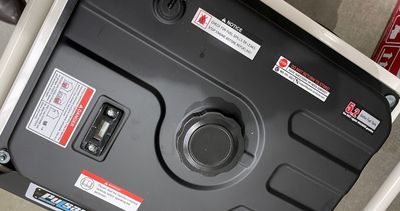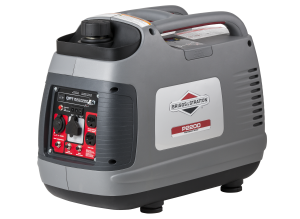Gas Leaks from Pulsar Generator (5 Checkpoints)
A fuel leak is likely the cause of the gas smell emanating from your generator. Because it might be difficult to identify a leak, especially if any traces of the leak have gone, I have included the most frequent sites for a leak to form.
When the carburetor bowl gasket on a Pulsar generator wears out or the float becomes caught, gas can leak out. It can also seep out of the fuel shutoff valve, fuel tank, fuel lines, and fuel filter.
Keep the generator in a cool, well-ventilated place at all times.

Before diagnosing, repairing, or operating, be sure you’ve read and understood all of the safety recommendations in the equipment’s operator’s manual.If you are unsure about how to proceed or if you lack the necessary expertise or experience, you should seek the assistance of a professional.
Table of Contents
Gas from a Pulsar Generator is Escaping Here
The Pulsar Generator Carburetor
Look for leaks in the carburetor. After leaving the gasoline tank, some fuel is temporarily stored here.
Varnish formed from gas sitting in the carburetor might cause its small pieces to stick, preventing the carburetor from controlling the amount of fuel entering the engine. This may lead to it spilling over.
A leak might be caused by the carburetor bowl gasket failing or by a malfunctioning internal part.
Carburetor bowl gasket failure on the Pulsar generator
Start by inspecting the carburetor’s bowl attachment. A thin gasket resembling a rubber band between the carburetor and the bowl.
The gasket is used to prevent gas leakage between the two parts. When it stops sealing, gas will leak out.
This gasket usually gets hard and brittle after some time. Since the gasket is so close to the engine, its temperature rises when the engine is in operation and falls when it is turned off.
The gasket was unable to maintain its seal because of the repeated stress of being heated and then cooled. A replacement carburetor bowl gasket should be purchased and installed if a leak is discovered here.
How to Change the Gasket in the Carburetor Bowl:
- Use the fuel shut-off valve to stop the fuel flow. If your generator doesn’t have a fuel valve, you can crimp the fuel line with a pair of pinch pliers to halt the flow.
- Before removing the bowl, wipe the outside of the carburetor to prevent dirt from falling into the unit.
- Keep a towel or other small receptacle handy to wipe out the bowl and save any remaining gasoline.
- It’s possible to remove the fuel bowl’s contents using a screw on the carburetor’s side. If yours has this problem, you can fix it by unscrewing the fuel drain and pouring the petrol into a container. Otherwise, continue on to the next section.
- Take off the bowl of the carburetor by unscrewing it.
- Take out the old gasket and put in the new one.
- Put the carburetor bowl back in place.
- Put the screw back in the bowl’s carburetor.
- If there was any fuel spillage, clean the carburetor once more.
- Start the engine with the fuel pump running to make sure the carburetor isn’t leaking any more.
The Pulsar generator’s float tank is jammed
Locate the air intake port next and check for fuel leaks. If you discover a leak here, it may be due to a trapped float that is preventing the correct amount of gasoline from entering the bowl.
When the float in your carburetor gets stuck, fuel keeps pouring into the bowl and eventually spills out.
When you discover a stuck float, you need to disassemble your carburetor to find out why. The float may not stick if you maintain the carburetor clean.
To get the carburetor functioning properly, you may need to either rebuild it or replace it.
Carburetor float needle jammed on Pulsar generator
The float needle should be the last part of the carburetor you inspect. The float needle cooperates with the float to maintain fuel delivery to the carburetor bowl. The needle will need to be fixed if it becomes jammed.
You can either disassemble the carburetor yourself to replace the float, or take it to a small engine specialist.
The Pulsar Generator’s Fuel Filter Is Cracked or Soggy
Next, if your model generator has an inline plastic fuel filter, inspect that. (The fuel filter in many Pulsar generators is either at the bottom of the fuel tank or is a narrow filter inserted in a fuel component, both of which are inconveniently out of the way).
Gas leaks can occur if the plastic housing is damaged in any way, especially if the plastic has grown soft.
As time passes, gas can deteriorate polymers. Your fuel filter can soften and eventually leak if you don’t change it regularly.
If your filter has a leak because of a crack or because it is made of flimsy plastic, you should get a new one.
Take care to avoid damaging the gasoline lines when disconnecting the inline filter. The fuel lines are vulnerable to damage from the brittle plastic.
Your Pulsar Generator’s Gas Tank Exploded
The fuel tank on your Pulsar generator might be made of metal or HDPE. Both types are equally susceptible to leaking as they get older.
A fuel leak may occur if the polyethylene tank’s seams failed. When gas is left in a metal tank, it can corrode and generate rust spots, which can lead to a hole.
When a fuel tank leak is discovered, a replacement tank should be installed immediately.
However, you might not have this choice if your vehicle has a metal tank and is an older model that is no longer produced. You can try patching up the damage.
The Pulsar Generator’s Defective Safety Valve
The fuel shut-off valve often develops a leak. Whether the Pulsar generator’s valve is plastic or metal, it will leak eventually.
When the seal on a shut-off valve with a sediment bowl fails, water might spill out. The fuel shutoff valve has to be replaced. The seal around the sediment bowl should be checked for leaks.
Generator Fuel Lines
Dry and brittle is what time does to fuel lines. Fuel will begin leaking through the fractures in them as time passes. Repairing a fuel line is not an option if it has a crack.
Make that the hose is properly attached to the fuel system components and that there is no fuel leaking out.







